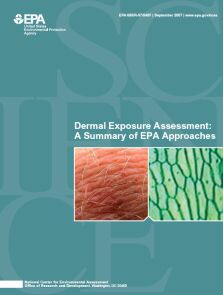Dermal Exposure Assessment: A Summary of EPA Approaches
Alert
Notice
EPA is announcing the completion of the final report, Dermal Exposure Assessment: A Summary of EPA Approaches and its availability to the public.
Abstract
This final report presents a concise description and evaluation of the approaches used in the Agency for dermal exposure assessment including a discussion about harmonization and research needs in this area. The report is intended to be used by EPA program offices in their efforts to refine and revise the methods they use to assess dermal exposure to chemicals in the environment and to facilitate cooperation in the development of new methods, models and guidance for dermal exposure assessment. This report was produced as a result of an internal dialogue among a group of exposure assessors from different Agency programs. When the Office of Pollution Prevention and Toxics (OPPT) began an update of its Chemical Screening Tool for Exposures and Environmental Releases and Consumer Exposure Models in 2003, the staff convened meetings with various experts on dermal exposure assessment from around the Agency to discuss recent advances and the current state of dermal exposure assessment practice. These experts recognized there would be a benefit to describe the different approaches used to conduct dermal exposure assessment in the Agency. The result would increase awareness and understanding of alternate approaches to estimate dermal penetration and identify areas where approaches might be harmonized to exchange information and to share methods and data to improve the transparency of dermal exposure assessments in the Agency. To achieve this, the Agency’s Risk Assessment Forum (RAF) commissioned a report in 2004 documenting and comparing the approaches, assumptions, and methods used across the Agency for dermal exposure assessment.
This report was produced as a result of an internal dialogue among a group of exposure assessors from different Agency programs. When the Office of Pollution Prevention and Toxics (OPPT) began an update of its Chemical Screening Tool for Exposures and Environmental Releases and Consumer Exposure Models in 2003, the staff convened meetings with various experts on dermal exposure assessment from around the Agency to discuss recent advances and the current state of dermal exposure assessment practice. These experts recognized there would be a benefit to describe the different approaches used to conduct dermal exposure assessment in the Agency. The result would increase awareness and understanding of alternate approaches to estimate dermal penetration and identify areas where approaches might be harmonized to exchange information and to share methods and data to improve the transparency of dermal exposure assessments in the Agency. To achieve this, the Agency’s Risk Assessment Forum (RAF) commissioned a report in 2004 documenting and comparing the approaches, assumptions, and methods used across the Agency for dermal exposure assessment. This report was then used as the basis for the dialogue at a RAF sponsored cross-Agency colloquium, the Colloquium on Dermal Exposure Methods Comparison in 2005, to identify common factors and differences of dermal exposure assessment methods, to identify opportunities for harmonization among different dermal exposure assessment methods, and to determine future research needs (U.S. EPA, 2005). Coincidentally, the RAF report and colloquium coincided with NCEA research efforts to evaluate methods to estimate permeability coefficients (Kp) and to assess the importance of dermal exposure to chemically contaminated water, soil, and sediment, leading to the development of this report.
Impact/Purpose
The report is intended to be used by EPA program offices in their efforts to refine and revise the methods they use to assess dermal exposure to chemicals in the environment and to facilitate cooperation in the development of new methods, models and guidance for dermal exposure assessment.Status
This is the Final Report.Citation
U.S. EPA. Dermal Exposure Assessment: A Summary of EPA Approaches. U.S. Environmental Protection Agency, Washington, DC, EPA/600/R-07/040F.History/Chronology
| Date | Description |
|---|---|
| 01- 2003 | The Office of Pollution Prevention and Toxics begins to update of its Chemical Screening Tool for Exposures and Environmental Releases and Consumer Exposure Models. |
| 02- Aug 2004 | The Risk Assessment Forum (RAF) commissions a report to document and compare the approaches, assumptions, and methods used across the Agency for dermal exposure assessment. |
| 03- Apr 2005 | The RAF convenes the Colloquium on Dermal Exposure Methods Comparison. |
| 04- Dec 2006 | NCEA completes internal review draft report. |
| 05- May 2007 | NCEA addreses comments and completes external review draft report. |
| 06- Jul 2007 | Oak Ridge Institute for Science and Education conducts an independent peer review of the report. |
| 07- Sep 2007 | NCEA addresses comments and releases the final report. |
Additional Information
Contacts include:Michael Dellarco, Dr Ph,
National Center for Environmental Assessment
202-564-3239
Dellarco.Mike@epa.gov
Gary W. Bangs, MPH, CIH, Capt. USPHS
Risk Assessment Forum
202-564-6667
Bangs.Gary@epa.gov
Download(s)
Related Link(s)
- EPA COUNCIL FOR ENVIRONMENTAL REGULATORY MODELING (CREM)
- EPA CENTER FOR EXPOSURE ASSESSMENT MODELING (CEAM)
- THE OFFICE OF POLLUTION PREVENTION AND TOXICS (OPPT) EXPOSURE ASSESSMENT METHODS, DATABASES, AND PREDICTIVE MODELS
- RISK ASSESSMENT GUIDANCE FOR SUPERFUND (RAGS), VOLUME I: HUMAN HEALTH EVALUATION MANUAL (PART E, SUPPLEMENTAL GUIDANCE FOR DERMAL RISK ASSESSMENT) INTERIM
